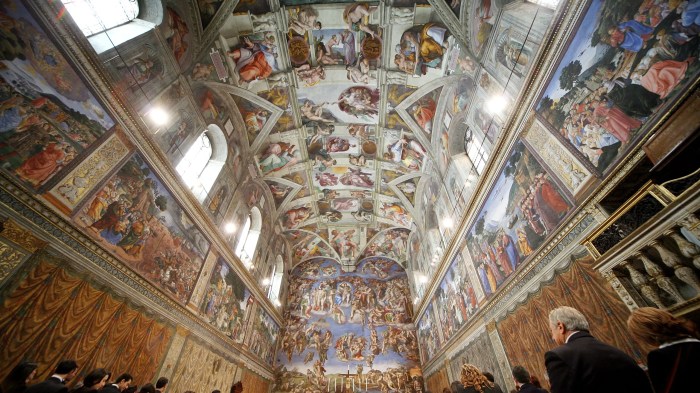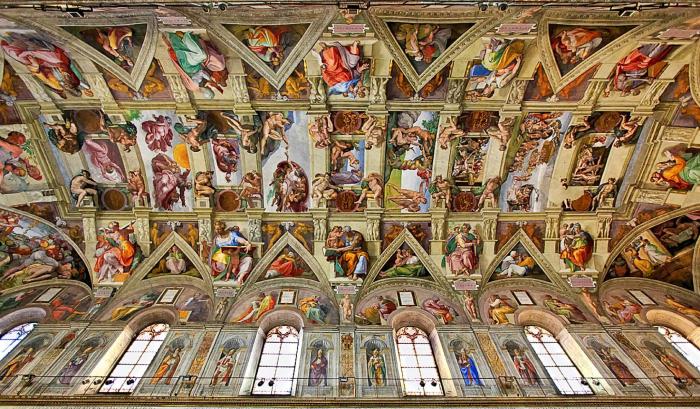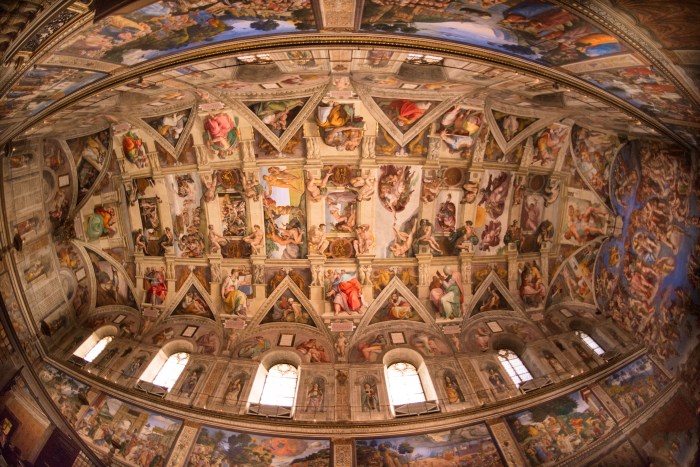Images of Michelangelo’s ceiling of the Sistine Chapel present a captivating journey into the realm of art and spirituality. This extraordinary masterpiece, a testament to the genius of the Renaissance, has captivated audiences for centuries with its breathtaking beauty and profound theological symbolism.
Michelangelo’s ceiling frescoes, executed over a period of four years, depict scenes from the Book of Genesis and the life of Christ. Through his masterful use of fresco technique and his unparalleled understanding of human anatomy, Michelangelo created a visually stunning and emotionally resonant work of art that continues to inspire and awe viewers today.
Visual Masterpiece: The Ceiling of the Sistine Chapel: Images Of Michelangelo’s Ceiling Of The Sistine Chapel Present
Michelangelo’s ceiling frescoes in the Sistine Chapel are a testament to the artist’s unparalleled talent and profound impact on Western art. Completed in 1512, the ceiling depicts biblical scenes and figures with extraordinary detail and realism.
Michelangelo employed various techniques, including fresco and secco, to create the monumental artwork. He used bold colors and dynamic compositions to enhance the drama and emotional impact of the scenes.
Central Scenes and Theological Symbolism
The central scenes of the ceiling depict the Creation, the Fall of Man, the Prophets, and the Sibyls. These scenes are rich in theological symbolism, reflecting the Catholic Church’s teachings on human history and salvation.
The Creation scenes show God creating the world and humanity, while the Fall of Man portrays the expulsion of Adam and Eve from the Garden of Eden. The Prophets and Sibyls represent the pre-Christian and non-Christian figures who foretold the coming of Christ.
Biblical Narratives in Art
Michelangelo’s ceiling frescoes depict key biblical stories from the Old Testament. These include the Creation, the Fall of Man, the Flood, and the stories of Noah, Moses, and David.
Michelangelo’s interpretation of these stories is deeply personal and often deviates from traditional iconography. For example, his depiction of the Creation shows God as a muscular, bearded figure, a departure from the more ethereal representations common at the time.
Artistic Choices and Compositional Strategies
Michelangelo’s artistic choices and compositional strategies contribute to the narrative power of the ceiling frescoes. He uses foreshortening and perspective to create the illusion of depth and movement.
The figures in the frescoes are arranged in complex and dynamic poses, conveying a sense of drama and urgency. The use of color and light further enhances the emotional impact of the scenes.
Anatomical Marvels

Michelangelo’s Sistine Chapel ceiling is renowned for its remarkable anatomical precision and realism. The figures are depicted with accurate muscle structure, proportions, and poses, demonstrating Michelangelo’s extensive study of human anatomy.
Michelangelo’s anatomical knowledge influenced his artistic style, leading to a shift from the idealized forms of classical art to a more naturalistic and expressive approach.
Influence on Subsequent Art and Artists
Michelangelo’s anatomical knowledge had a profound impact on subsequent art and artists. Artists such as Raphael, Leonardo da Vinci, and Titian studied Michelangelo’s work to improve their understanding of human anatomy and movement.
The influence of Michelangelo’s anatomical precision can be seen in the works of artists from the Renaissance to the present day, including Bernini, Rodin, and Picasso.
Influence on Art History

Michelangelo’s Sistine Chapel ceiling has had a profound impact on Western art. It inspired subsequent generations of artists and established a new standard for ceiling frescoes.
The ceiling’s dynamic compositions, anatomical precision, and narrative power have influenced countless artists, from Raphael and Bernini to Picasso and Jackson Pollock.
Comparison with Other Notable Ceiling Frescoes
Michelangelo’s Sistine Chapel ceiling stands as a masterpiece among ceiling frescoes. It surpasses other notable examples, such as Giotto’s frescoes in the Scrovegni Chapel in Padua, in terms of its scale, complexity, and artistic achievement.
Michelangelo’s ceiling frescoes have influenced the design and execution of ceiling frescoes in churches and other grand spaces, shaping the aesthetic and iconographic traditions of Western art.
Contemporary Interpretations

Michelangelo’s Sistine Chapel ceiling continues to inspire and influence contemporary artists. Modern and contemporary artists have reinterpreted and reimagined the iconic imagery in various mediums.
For example, the artist Damien Hirst created a series of paintings entitled “The Agony and the Ecstasy,” which explore the themes of pain and suffering depicted in Michelangelo’s ceiling frescoes.
Evolution and Transformation of Michelangelo’s Influence
The influence of Michelangelo’s Sistine Chapel ceiling has evolved and transformed over time. Contemporary artists have reinterpreted Michelangelo’s imagery in new and innovative ways, using digital technologies, mixed media, and conceptual approaches.
The evolution of Michelangelo’s influence reflects the changing artistic and cultural landscape, as well as the ongoing relevance of his masterpiece in contemporary art.
Interactive Experience: Digital and Immersive
Digital and immersive technologies offer new possibilities for exploring and appreciating Michelangelo’s Sistine Chapel ceiling.
A hypothetical interactive digital experience could allow users to zoom in on the frescoes, examine the details, and learn about the biblical stories and symbolism behind them.
Virtual Tour and Interactive Annotations, Images of michelangelo’s ceiling of the sistine chapel present
A virtual tour could provide a detailed and immersive experience, guiding users through the ceiling’s scenes and highlighting key elements. Interactive annotations could offer historical and artistic context, enhancing the user’s understanding of the artwork.
Immersive technologies, such as virtual reality, could further enhance the experience, allowing users to feel as if they are standing beneath the ceiling and experiencing its grandeur firsthand.
Helpful Answers
What techniques did Michelangelo use to create the Sistine Chapel ceiling frescoes?
Michelangelo employed the fresco technique, painting on wet plaster with water-based pigments. This method allowed him to achieve a luminous and durable finish.
How many scenes are depicted on the Sistine Chapel ceiling?
The ceiling features a total of nine central scenes from the Book of Genesis, as well as numerous smaller scenes and figures.
What is the significance of the Creation of Adam?
The Creation of Adam, one of the most iconic images in Western art, depicts the moment when God breathes life into Adam, the first human. It symbolizes the divine creation of humanity and the relationship between God and humankind.